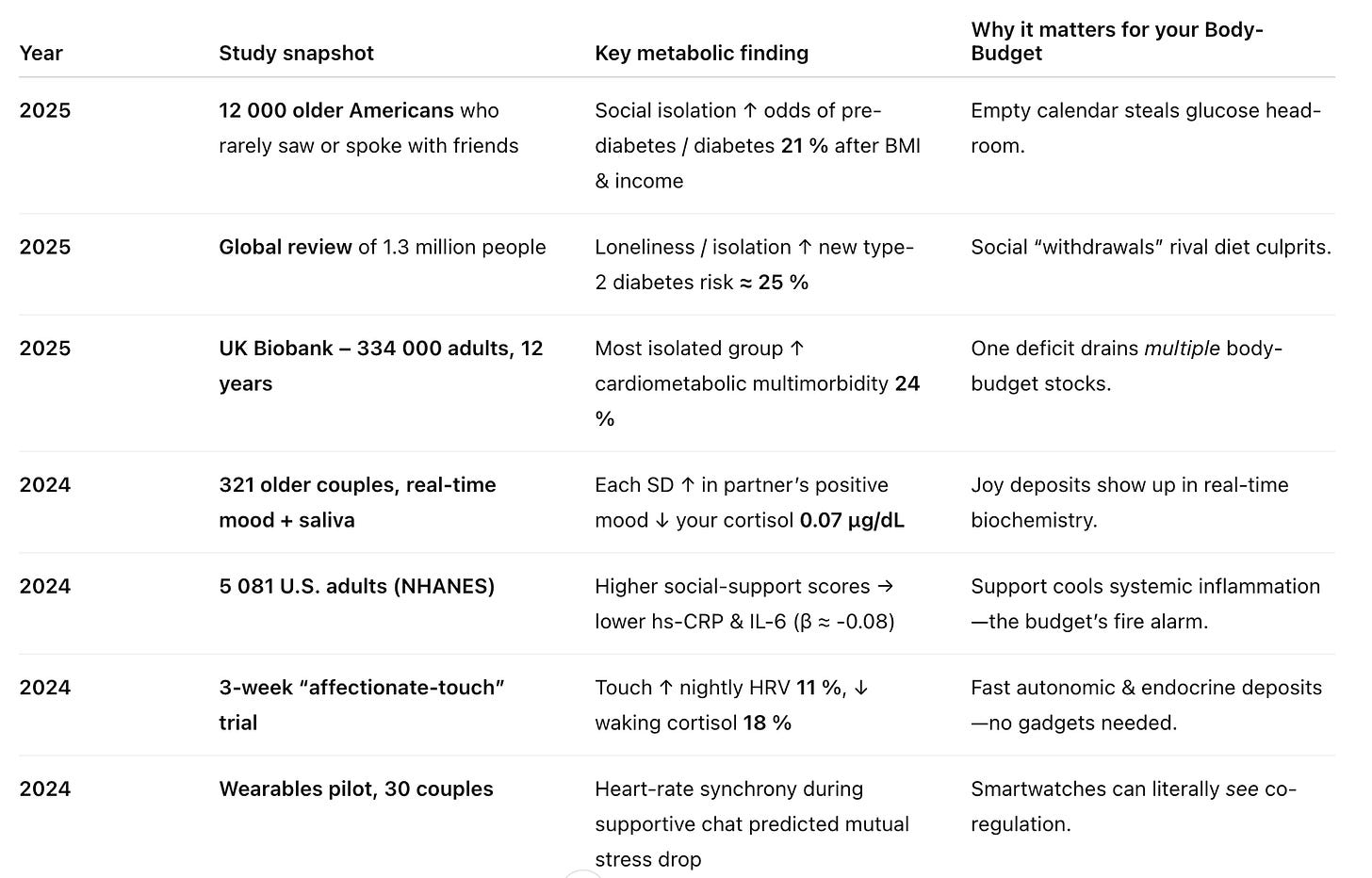Human connection vs. Biohacks: How your relationships rewire your metabolic health
And why your next cortisol fix could be a group chat, not an ice bath.
“Show me who you spend time with, and I’ll show you the state of your mitochondria.” —said no one, but they should have.
(Stay with me for the why—and grab your free 7-day Co-Regulation Cheat-sheet in Section 6.)

1. I tried every hack in the book. And something still felt off
In April, I posted an essay arguing that friendship and connection are as vital as food. Gratitude flowed in, but then a hollow feeling swept through me.
Why?
After more than a decade of consistent habits, a good sleep routine, proper nutrition, movement, sauna, therapy, and journaling, something still felt off.
Ever felt that too, doing everything “right,” yet missing a connection you can’t name?
Two weeks later, knee-deep in AGEs research for another post, I’m earbuds-in when nutrition scientist Dr. Michelle Davenport drops this:
“If you have access to a kitchen and a bed, the sun, a place to move and loved ones around, you pretty much have everything you need to live a healthy life.”
The part about loved ones hit me like a train. I’d been thousands of km away from my closest circle of friends for years, and my body was keeping score. In an instant, my brain connected the dots:
Donella Meadows’ rule of every system, “stocks–flows–feedback”.
Lisa Feldman Barrett’s 24-hour body-budget model
Dr. Michelle’s reminder that people are the ultimate inflow.
They echoed in unison:
“Your nervous system responds to relationships first, then to routines.
Safety is co-regulated. Who you’re with shapes your biology.”
But what does this look like in real life? Let me take you back to a little story about my friend Anca, happening in the spring of 2020…
2. Lockdown calls with a friend: A story of co-regulation

Spring 2020. Outside my London flat, the streets are silent, except for one cheeky bird who has the stage. I can hear it because the car noises are nowhere to be found these days, and the world as we know it is rapidly changing.
I grab my phone to call Anca, whom I hadn’t seen since 2019 when she left Amsterdam for the US. A call turns into a weekly ritual: mug of tea in one hand, headphones in the other, life downloads spilling across the Atlantic.
Mid-conversation, she lets out a long, rib-cage sigh. My shoulders drop; I hadn’t noticed they were up to my ears.
Forty minutes later, laughing, she says: “Every time we talk, I feel lighter by the end of the call.” And in an instant, I realise I feel the same way.
Neither of us knew that yet, but we’d just experienced co-regulation: two nervous systems syncing over Wi-Fi, trading cortisol for calm.
It takes that to notice a brutal contrast: how a quarrel with my flatmate R flips the script into dysregulation in minutes. One unfriendly remark and my heart rate rockets past 110, mouth dry, body tense.
Same body, opposite input; the ledger flips red in seconds.
That’s when it clicks: all the metrics I see in apps are echoes of the conversations and human interactions I have, a token of my lived experience.
Blue-Zone elders don’t outlive us because of diet alone; they feast on community and belonging.
So go text that someone you trust and count how many exhales it takes before your shoulders drop.
3. The Body-budget ledger: People in, cortisol out
Remember that rib-cage sigh I mentioned earlier? Here’s WHY it matters. According to Meadows, a system is “stocks–flows–feedback”. If we label ours the Body-Budget Ledger, then it looks like this:
When deposits exceed withdrawals, there is a surplus of energy, which leads to strong immunity and high HRV (heart rate variability); both are indicators of an adaptable and resilient nervous system.
Flip the equation, and you get inflammation, insomnia, and weight gain.
The catch? The ledger isn’t a closed-circuit inside your skull. Most wellness advice focuses on increasing inflow through solo protocols: cold plunges, blue-light glasses, breath-holds, you name it.
That’s because the solo protocol illusion feels concrete; relationships feel slippery. We can set timers, but a friend’s availability is a factor we can’t control.
So we default to what we can measure, the “wrong-goal” trap that Meadows warns about in her systems thinking. We optimise behaviours instead of buffers (community, trust) because they fit in our apps and spreadsheets.
But buffers are exactly what make a system resilient. Both Barrett’s data and my lockdown calls with Anca support that claim.
Numbers shift faster when:
You add richer, warmer human signals and prune chronic threat signals.
Your environment makes it easy for your body to feel safe.
So before you add another routine to your morning stack, ask the question that rewires your system:
Who can I connect with now?
4. When evidence says it all: Your social circle beats cold plunges
Seven new studies, one verdict: warm human connections beat cold plunges.
Here’s the proof found through my scrounging:
*See footnotes for sources
5. Two-week experiment: Dinner with friends vs the “perfect” routine
With this data in mind, I’d like to propose an experiment.
The setup
A two-week sprint where we alternate two protocols: Protocol A in week 1 and Protocol B in week 2.
Protocol A: The “Perfect” solo routine (yours will probably look different)
Sunrise exposure
Cold plunge/cold shower
10k steps walk
Protocol B: Humans at the table
Skip the plunge, and replace it with hosting dinner with two friends.
My readouts (Oura + CGM) after having tried this were:
Just one variable changed: humans across the table.
Screenshot this table, try your A vs B week, and either share your results in the comments section or DM me your numbers.
6. Eat, connect, repeat: A recipe + A 7-Day Challenge
Stephen King says fiction is a telepathy machine: his thoughts jump from his head to yours through squiggles on paper.
Friendship and connection are the biological version of that magic.
Every laugh, sigh, and silent nod is a packet of data that your neurons translate into safety or threat. Meadows would call this an information flow with the highest leverage point in the whole system.
Let’s then, turn tables into test-beds. Because data is cool, but dinner is cooler.
1. Download the 7-Day Co-Regulation challenge below
2. Cook the Fish stew recipe below.
3. Share it with friends, then check your HRV tomorrow, and DM me the screenshot. Best jumps land in next week’s notes.
Onto the recipe.
Four friends’ fish stew
This is by far one of my favourite homeland recipes, and I always go back to it when I feel homesick. The best part of cooking it? Prep once. Nourish many.
Serves: 4
Prep time: 10 mins
Cooking time: 45 - 50 mins
Ingredients:
1.5 kg carp and bream (or a mix of bream, trout and carp for a deeper flavour)
1 medium red onion
3-4 medium peppers (a mix of romano (pointed) and bell peppers, of different colours)
6 medium tomatoes
1 garlic head
1 chilli pepper
2 sprigs of thyme and 1-2 sprigs of rosemary
Parsley
Salt and pepper to taste
Method:
If you are using a mix of fish, as I recommend above, keep one fish whole and slice the other into 3 cm chunks.
Wash all the tomatoes, peppers, capsicum, chilli and onion (first layer peeled), and place them on a baking tray.
Cut the top part of the garlic head, season with salt and pepper, and sprinkle with a bit of olive oil. Then, cover it with baking paper and close it in a small sachet.
Place your fish on the tray too and season with salt and pepper.
Place the tray in the oven and bake for 20-25 minutes at 180 °C.
When everything’s done, take it out of the oven. Let the veggies cool a bit, then clean the skin of the tomatoes and bell peppers. Next, dice the peppers and onion, and squeeze the baked garlic cloves out.
In a Dutch oven (or any other pot you have at hand), add a spoonful of ghee, one rosemary sprig, two thyme sprigs, and two fresh garlic cloves.
After 2 minutes, add the tomatoes, diced onion, peppers, and baked garlic, and let everything simmer for about 15 minutes—season with salt and pepper.
Then, add the fish and let it continue to cook for another 10 minutes.
Once everything is cooked, finely chop 5-10 sprigs of fresh parsley and add them on top. Serve with polenta.
After all the data that I gathered, the tables, and the research papers, the conclusion is embarrassingly simple:
People are the protocol.
As always, thank you for reading Salt, Pepper, Stories. If this post helped you, give it a heart, comment or share it with someone who is in need of a big hug and some delicious food.
xx, Ana
¹ Chen X et al. “Social Isolation and Incident Prediabetes or Diabetes in Older U.S. Adults.” *Endocrine Society Meeting (ENDO-25) Abstract P47* (2025). doi-pending.
² Li F, Zhang Y, Wang P et al. “Loneliness, Social Isolation, and Risk of Type 2 Diabetes: A Systematic Review and Meta-Analysis.” *Diabetes Research and Clinical Practice* 210 (2025): 110127. doi:10.1016/j.diabres.2025.110127
³ Garate-Vera A et al. “Social Isolation and Cardiometabolic Multimorbidity: Prospective Analysis of 334 000 UK Biobank Participants.” *iScience* 27 (4) (2025): 109876. doi:10.1016/j.isci.2025.109876
⁴ Papp LM, Kouros CD. “Partner Positive Affect Predicts Lower Momentary Cortisol in Daily Life.” *Psychoneuroendocrinology* 161 (2024): 106715. doi:10.1016/j.psyneuen.2024.106715
⁵ Ramesh J et al. “Perceived Social Support Is Associated with Lower hs-CRP and IL-6: NHANES 2017–2020.” *Therapeutic Advances in Endocrinology & Metabolism* 16 (2024): 2042018824123456. doi:10.1177/2042018824123456
⁶ Serrano González A et al. “Daily Affectionate Touch Intervention Improves Heart-Rate Variability and Lowers Morning Cortisol.” *Psychoneuroendocrinology* 157 (2024): 106384. doi:10.1016/j.psyneuen.2023.106384
⁷ Patel M et al. “Heart-Rate Synchrony During Supportive Conversations Detected by Consumer Wearables.” *JMIR mHealth and uHealth* 12 (2024): e56789. doi:10.2196/56789









